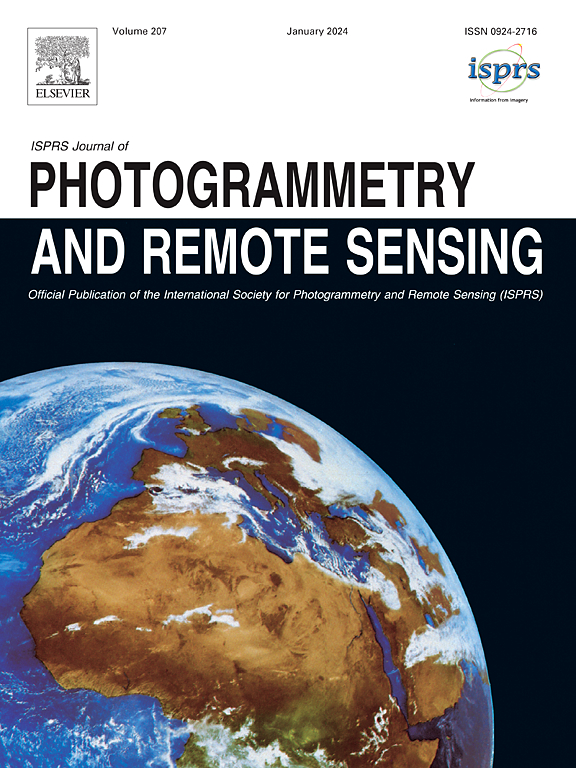PRISMethaNet:利用 PRISMA 卫星数据检测垃圾填埋场甲烷的新型深度学习模型
IF 10.6
1区 地球科学
Q1 GEOGRAPHY, PHYSICAL
ISPRS Journal of Photogrammetry and Remote Sensing
Pub Date : 2024-10-20
DOI:10.1016/j.isprsjprs.2024.10.003
引用次数: 0
摘要
甲烷(CH4)是最重要的温室气体之一,自工业化前时代以来,约有三分之一的气候变暖是由甲烷造成的,其来源多种多样。垃圾填埋场排放的 CH4 占了很大比例,而人口增长也会增加这些排放。因此,实现垃圾填埋场 CH4 监测过程的自动化至关重要。本研究利用 PRISMA 卫星在 400-2500 nm 光谱范围内的数据,提出了一种具有 Atrous Spatial Pyramid Pooling(ASPP)机制的卷积神经网络(CNN),称为 PRISMethaNet,用于实现 CH4 检测过程的自动化。我们以印度、尼日利亚、墨西哥、巴基斯坦、伊朗等多个国家的 17 个垃圾填埋场共 41 幅 PRISMA 图像为研究区域。使用增强数据作为输入对 PRISMethaNet 模型进行了训练,并通过匹配滤波 (MF) 算法获得了羽流掩模。这个新提出的模型成功地检测到了羽流,其总体准确度(OA)、F1 分数(F1)、精确度和召回率分别为 0.99、0.96、0.93 和 0.99,量化不确定性介于 11 % 到 58 % 之间。使用梯度加权类活化映射(Grad-CAM)算法对 ASPP 模块进行的开箱分析表明,较大的扩张率(DR)与 CH4 羽流可探测性之间存在密切关系。重要的是,研究结果表明,与以往研究中使用的统计方法相比,PRISMethaNet 所获得的羽流掩模能提供更准确的 CH4 量化率。特别是,PRISMethaNet 的均方误差 (MSE) 约为 1,102 千克/小时,而常用统计方法的均方误差约为 1,974 千克/小时。本文章由计算机程序翻译,如有差异,请以英文原文为准。
PRISMethaNet: A novel deep learning model for landfill methane detection using PRISMA satellite data
Methane (CH4) is one of the most significant greenhouse gases responsible for about one-third of climate warming since preindustrial times, originating from various sources. Landfills are responsible for a large percentage of CH4 emissions, and population growth can boost these emissions. Therefore, it is vital to automate the process of CH4 monitoring over landfills. This study proposes a convolutional neural network (CNN) with an Atrous Spatial Pyramid Pooling (ASPP) mechanism, called PRISMethaNet, to automate the CH4 detection process using PRISMA satellite data in the 400–2500 nm spectral range. A total number of 41 PRISMA images from 17 landfill sites located in several countries, such as India, Nigeria, Mexico, Pakistan, Iran, and other regions, were used as our study areas. The PRISMethaNet model was trained using augmented data as the input, and plume masks were obtained from the matched filter (MF) algorithm. This novel proposed model successfully detected plumes with overall accuracy (OA), F1-score (F1), precision, and recall of 0.99, 0.96, 0.93, and 0.99, respectively, and quantification uncertainties ranging from 11 % to 58 %. An unboxing of the ASPP module using Gradient-weighted Class Activation Mapping (Grad-CAM) algorithm demonstrated a strong relationship between larger dilation rates (DRs) and CH4 plume detectability. Importantly, the results highlighted that plume masks obtained by PRISMethaNet provided more accurate CH4 quantification rate compared to the statistical methods used in previous studies. In particular, the mean square error (MSE) for PRISMethaNet was approximately 1,102 kg/h, whereas the MSE for the commonly used statistical method was around 1,974 kg/h.
求助全文
通过发布文献求助,成功后即可免费获取论文全文。
去求助
来源期刊

ISPRS Journal of Photogrammetry and Remote Sensing
工程技术-成像科学与照相技术
CiteScore
21.00
自引率
6.30%
发文量
273
审稿时长
40 days
期刊介绍:
The ISPRS Journal of Photogrammetry and Remote Sensing (P&RS) serves as the official journal of the International Society for Photogrammetry and Remote Sensing (ISPRS). It acts as a platform for scientists and professionals worldwide who are involved in various disciplines that utilize photogrammetry, remote sensing, spatial information systems, computer vision, and related fields. The journal aims to facilitate communication and dissemination of advancements in these disciplines, while also acting as a comprehensive source of reference and archive.
P&RS endeavors to publish high-quality, peer-reviewed research papers that are preferably original and have not been published before. These papers can cover scientific/research, technological development, or application/practical aspects. Additionally, the journal welcomes papers that are based on presentations from ISPRS meetings, as long as they are considered significant contributions to the aforementioned fields.
In particular, P&RS encourages the submission of papers that are of broad scientific interest, showcase innovative applications (especially in emerging fields), have an interdisciplinary focus, discuss topics that have received limited attention in P&RS or related journals, or explore new directions in scientific or professional realms. It is preferred that theoretical papers include practical applications, while papers focusing on systems and applications should include a theoretical background.
 求助内容:
求助内容: 应助结果提醒方式:
应助结果提醒方式:


